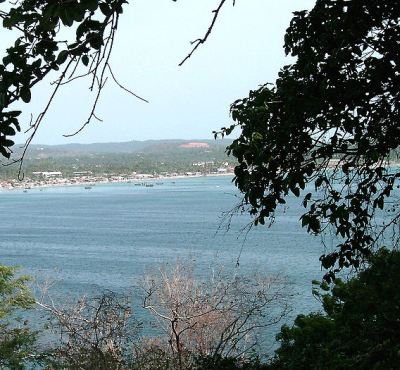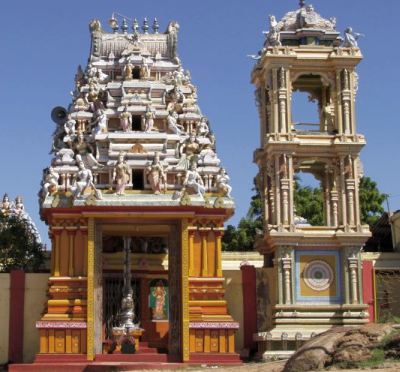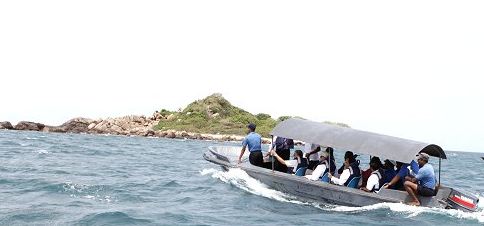Tricomalee Travel Guide
 Trincomalee is a port which lies on the east coast of the island,
Tricomalee is about 113 miles south of Jaffna city. The city is built on a
peninsula, which divides the inner and outer harbours. Overlooking the Kottiyar
Bay, Trincomalee is one of the main centers of Tamil speaking culture in Sri
Lanka.
Trincomalee is a port which lies on the east coast of the island,
Tricomalee is about 113 miles south of Jaffna city. The city is built on a
peninsula, which divides the inner and outer harbours. Overlooking the Kottiyar
Bay, Trincomalee is one of the main centers of Tamil speaking culture in Sri
Lanka.
The city is home to the famous ancient Koneswaram temple alluded to in its historic Tamil name Thirukonamalai from which its anglicized name is derived, and has been a sea port that has played a major role in the maritime and international trading history of Sri Lanka. It is referred to as Gokanna in Pali[1] or Gokarna in Sanskrit.trincomalee capital city of Hindu king ravanan and later around 13 cen rul by king sangili
The Bay of Trincomalee's harbour is renowned for its large size and security; unlike every other in the Indian Sea, it is accessible to all types of craft in all weathers. The beaches are used for surfing, scuba diving, fishing and whale watching. The city also has the largest Dutch fort in Sri Lanka. It is home to major Sri Lankan naval bases and a Sri Lankan Air Force base.
Trincomalee, is an anglicized form of the Tamil word "Tiru-kona-malai", meaning "Lord of the Sacred Hill"; a reference to the town's ancient Koneswaram temple.
Thiru in Tamil is "sacred", Kona means "Lord" or "Chief" while Malai in Tamil means mountain or hill.
Sanskrit texts, as well as an inscription unearthed by archeologists, call it Gokanna. The Vayu Purana refers to a Siva temple on Trikuta hill on the eastern coast of Lanka in the 3rd century. The Mahavamsa documents that the King Mahasena destroyed a Deva temple and built a Buddhist shrine in its stead to expiate for an earlier heresy on his part.
Tamil texts, as well as excavated inscriptions detail the Saivite principalities that formed in Trincomalee in service of the Koneswaram temple by the medieval age. The South Indian Tamil literature Tevaram of Tiru-gnana Sambandar makes mention to the Siva temple in Trincomalee in the 6th century.
 Hotels in Tricomale
Hotels in Tricomale
Palm Beach Guesthouse Trincomalee
Club Oceanic Trincomalee
Suriya Lagoon Guesthouse Nilaveli
Nilaveli Beach Hotel Trincomalee
Shivas Guesthouse Trincomalee
History of Tricomalee
Trincomalee has attracted seafarers like Marco Polo, Ptolemy and Sea Traders from China and East Asia since ancient times. Trinco, as it is commonly called, has been an important sea port since the days of the ancient Sri Lankan Kings. The earliest known reference to the port of Gokanna is found in the Mahavamsa stating that in 5th century BC, when King Vijaya who having failed to convince his brother to come to Sri Lanka as his successor, got down his youngest son Panduvasdeva, who landed at Gokanna and was subsequently enthroned at Upatissagama.
King Parakramabahu I used Gokanna (Trincomalee) as his eastern port, to launch a successful invasion of Burma in the 12th Century.[14] An English sea captain and historical chronicle writer named Robert Knox came ashore by chance near Trincomalee and surrendered to the Dissawa (official) of the King of Kandy in 1659. Hence, it was an important trade city between Sri Lanka and the outside world, and one of the British Empire's most important ports in Asia during the second world war.
Trincomalee had a Portuguese force during the reign of Kandyan King Rajasinghe I. Rajasinghe finally ended with an alliance with Dutch and the Dutch invaded Kottyar Bay Fort as their first attack. The fall of the Kottyar Bay Fort was the first nail in the Portuguese coffin.
Trincomalee was occupied by the Dutch, and subsequently by French alternately, until the capture of the fort there by the British in 1795. Trincomalee was the first land to be captured by the British who fought and defeated the Dutch, who did not want to surrender Ceylon as directed by the Prince of Orange, who took refuge in London after being defeated by the French republicans under Napoleon. As such Trincomalee has served as an entrance to a western invader from Calcutta.
Historical sites in Tricomalee
 The Koneswaram Temple.
The Koneswaram Temple.
Sri Lankan Tamils consider this place to be sacred to them and are widely believed to be the indigenous people of the area. Trincomalee and its environs have many Tamil Hindu sites of historical importance. These sites are sacred to the Hindus and some Buddhists worship in these Hindu sites.
Even though King Mahasena demolished the Sivan Temple and built a Mahayana Buddhist temple on the hilltop the Hindus of this area maintain a good peaceful relationships with the minority Sinhala Buddhists living in the area. This was possible because Hinduism being a peaceful religion was tolerant and does not advocate violence even when the Buddhist committed disruptive acts.
Hindu historical sitesThe Koṇēsvaram temple attracted pilgrims from all parts of India[citation needed]. The Koṇēsvaram shrine itself was demolished in 1622 by the Portuguese (who called it the Temple of a Thousand Columns), and who fortified the heights with the materials derived from its destruction[citation needed]. Some of the artefacts from the demolished temple were kept in the Lisbon Museum including the stone inscription by Kulakottan (Kunakottan)[citation needed]. It has an emblem including two fish and is engraved with a prophesy stating that, after the 16th century, westerners with different eye colours will rule the country for 500 years and, at the end of it, rule will revert back to Vadugus.[citation needed] The Hindu temple was also documented in several late medieval texts such as the Konesar Kalvettu[12] and the Dakshina Kailasa Puranam.
Buddhist historical sites
There are several Buddhist historical sites around the Trincomalee, meaning that there had been a Buddhist inhabitance in the area for many centuries. These include the famous Seruwila Mangala Raja Maha Vihara (Seruwila Temple), south of the trico town, which is under consideration to be declared a UNESCO world heritage site dating back to 2nd century B.C. the Sri Gajaba Len Vihara (Sri Gajaba Cave Temple), Tiriyay temple and the Welgam temple.
The Dutch Fort
The entrance to the roadway leading to Koneswaram is actually the entrance to what used to be Fort Fredrick. The fort was built in 1623 by the Portuguese and captured in 1639 by the Dutch. It then went through a phase of dismantling and reconstruction and was attacked and captured by the French in 1672.
The British in Trincomalee
The Trincomalee beachOn January 8, 1782 the British captured the fort but the French recaptured it on August 29 of the same year. In 1783 the French ceded it to the British and subsequently Britain ceded it to the Dutch. In 1795 the British recaptured and held it until Sri Lanka's independence in 1948. The importance of Fort Fredrick was due to Trincomalee's natural harbour. Through Trincomalee, it was believed a strong naval force could secure control of India's Coromandel Coast.
Prior to the Second World War the British had built a large airfield to house a permanent RAF base, RAF China Bay and a fuel storage and support facilities for the Royal Navy and HMS Highflyer naval base based there. After the fall of Singapore, Trincomalee became the home port of the Eastern Fleet of the Royal Navy, and submarines of the Dutch Navy. The harbour and airfield were attacked by a Japanese carrier fleet in April 1942 in the Indian Ocean Raid
Until 1957, Trincomalee was an important base for the Royal Navy and was home to many British people who were employed by the British Admiralty. One of the places inhabited by the British was Fort Fredrick which is now occupied by the Sri Lankan Army. Some of the old buildings in the fort were used as residences, including one previously occupied by The Duke of Wellington. In the early 1950s The British Government built groups of bungalows within the Fort specifically for their employees.
These bungalows still exist and provide accommodation for soldiers of the Sri Lankan Army. One of the groups of bungalows was named Edinburgh Terrace. Children of the British residents attended a Royal Naval School which was part of the Naval Base.
Post independence
Sri Lankan naval ship at TrincomaleeThe naval and air bases were take over by Sri Lanka in 1957, today SLNS Tissa and SLN Dockyard are used by the Sri Lankan Navy, while the Sri Lanka Air Force is based at SLAF China Bay. The Sri Lanka Army has its Security Forces Headquarters - East in Trincomalee.
Trincomalee War Cemetery, is one of the six commonwealth war cemeteries in Sri Lanka, it is maintained by Sri Lankan Ministry of Defence on behalf of the Commonwealth War Graves Commission.
The Navy Base is home to a naval museum called The Hoods Tower Museum. The name of the museum refers to a watchtower built on a hill commanding a 360-degree view of the harbor and the bay.
Harbour
Trincomalee's strategic importance has shaped its recent history. The great European powers vied for mastery of the harbour. The Portuguese, the Dutch, the French, and the English, each held it in turn, and there have been many sea battles nearby.
The harbour, the fifth largest natural harbour in the world, is overlooked by terraced highlands, its entrance is guarded by two headlands, and there is a carriage road along its northern and eastern edges.
Trincomalee's location, in a less well developed and sparsely populated area, has in the past hampered its own development. Nevertheless plans are under way to develop Trincomalee as a commercial seaport.
BeachesTrincomalee has some of the most picturesque and scenic beaches found in Sri Lanka, relatively unspoilt and clean. The area is famous for bathing and swimming, owing to the relative shallowness of the sea, allowing one to walk out over a hundred meters into the sea without the water reaching the chest. Whale watching is a common pastime in the seas off Trincomalee, and successful sightings are on the rise with the increase of tourism in the area.
The Trincomalee Beach in front of Chaaya Blu Resort, Trincomalee, in July 2010.[edit] Hot springsThere are the seven hot springs of Kanniya (Kal = stone; niya = land), on the road to Trincomalee. A high wall bounds the rectangular enclosure which includes all seven springs. Each is in turn enclosed by a dwarf wall to form a well. The water is warm, the temperature of each spring being slightly different. The use of the springs for bathing is controlled by the neighbouring Mari Amman Kovil, who holds the lease of the wells
3 Days Colombo Tricomalee & Pigeon Island Tour from Colombo
This is a unique tour offerred by Travel & Culture Services Sri Lanka. Detailed Itinerary is as under.
Day 01 Meet at your hotel drive to Tricomalee enroute visit the villages and remanants of war and some very interesting scenery On arrival check in at hotel. Dinner & Overnight at hotel.
Day 02 Full day Tour of Pigeon Island, the Marine National Park the newly re-opened Pigeon Island is a 41.4-hectare National Parkin Sri Lanka where you can see rare coral reefs, as well as the many species of Sri Lankan birds and, many varieties of migrating birds visiting this historical island. Overnight at hotel.
Day 03 Drive back to Colombo
Cost of the tour depends on how many people will you be and when you wish to travel. Please Contact us for costing to Booking details


